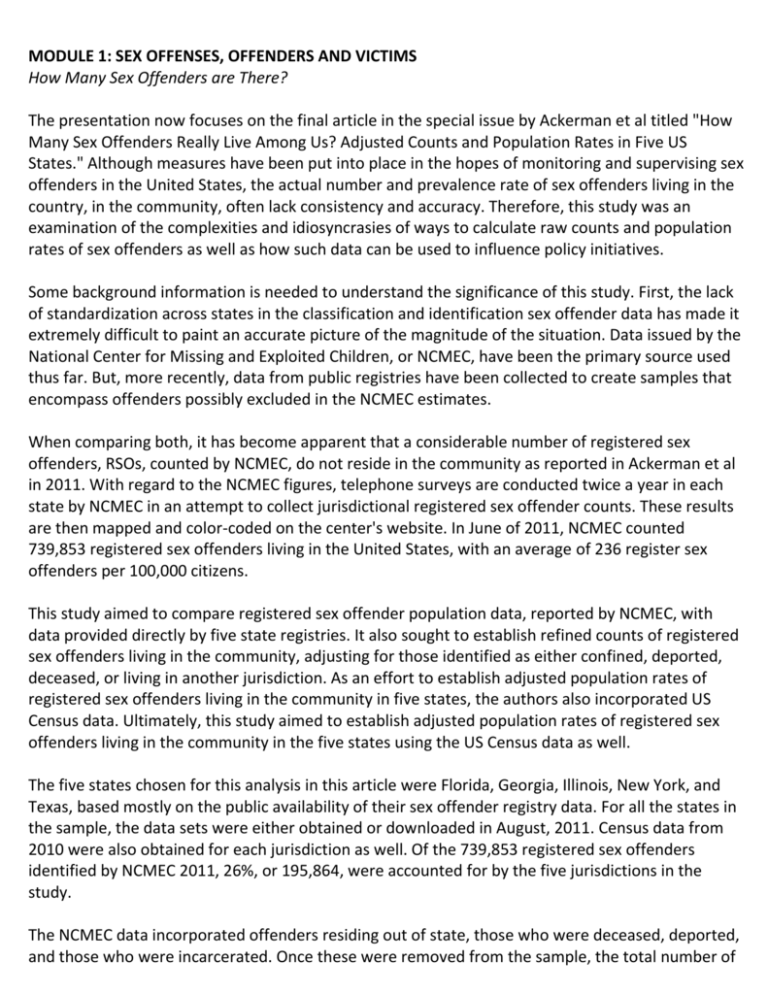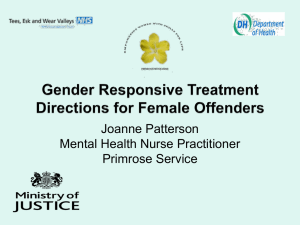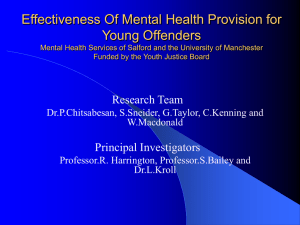
MODULE 1: SEX OFFENSES, OFFENDERS AND VICTIMS
How Many Sex Offenders are There?
The presentation now focuses on the final article in the special issue by Ackerman et al titled "How
Many Sex Offenders Really Live Among Us? Adjusted Counts and Population Rates in Five US
States." Although measures have been put into place in the hopes of monitoring and supervising sex
offenders in the United States, the actual number and prevalence rate of sex offenders living in the
country, in the community, often lack consistency and accuracy. Therefore, this study was an
examination of the complexities and idiosyncrasies of ways to calculate raw counts and population
rates of sex offenders as well as how such data can be used to influence policy initiatives.
Some background information is needed to understand the significance of this study. First, the lack
of standardization across states in the classification and identification sex offender data has made it
extremely difficult to paint an accurate picture of the magnitude of the situation. Data issued by the
National Center for Missing and Exploited Children, or NCMEC, have been the primary source used
thus far. But, more recently, data from public registries have been collected to create samples that
encompass offenders possibly excluded in the NCMEC estimates.
When comparing both, it has become apparent that a considerable number of registered sex
offenders, RSOs, counted by NCMEC, do not reside in the community as reported in Ackerman et al
in 2011. With regard to the NCMEC figures, telephone surveys are conducted twice a year in each
state by NCMEC in an attempt to collect jurisdictional registered sex offender counts. These results
are then mapped and color-coded on the center's website. In June of 2011, NCMEC counted
739,853 registered sex offenders living in the United States, with an average of 236 register sex
offenders per 100,000 citizens.
This study aimed to compare registered sex offender population data, reported by NCMEC, with
data provided directly by five state registries. It also sought to establish refined counts of registered
sex offenders living in the community, adjusting for those identified as either confined, deported,
deceased, or living in another jurisdiction. As an effort to establish adjusted population rates of
registered sex offenders living in the community in five states, the authors also incorporated US
Census data. Ultimately, this study aimed to establish adjusted population rates of registered sex
offenders living in the community in the five states using the US Census data as well.
The five states chosen for this analysis in this article were Florida, Georgia, Illinois, New York, and
Texas, based mostly on the public availability of their sex offender registry data. For all the states in
the sample, the data sets were either obtained or downloaded in August, 2011. Census data from
2010 were also obtained for each jurisdiction as well. Of the 739,853 registered sex offenders
identified by NCMEC 2011, 26%, or 195,864, were accounted for by the five jurisdictions in the
study.
The NCMEC data incorporated offenders residing out of state, those who were deceased, deported,
and those who were incarcerated. Once these were removed from the sample, the total number of
registered sex offenders decreased by 43%. As a result of the decreased number of registered sex
offenders in each jurisdiction, the state rates also declined.
Florida started with a sample size of 300 and dropped to 132. Georgia from 195 to 134. Illinois
stayed the same. New York from 165 to 70. And Texas from 264 to 212. This table shows the
comparisons of the NCMEC estimates, based on the dark, black bar, compared to the estimates that
are derived in this study once you remove those who are either residing out of state, deceased,
deported, and incarcerated. So you can see there's a different story that can be told, depending on
how you accurately report the data.
There was some consistency in the trends with regard to registered sex offenders, even from this
limited jurisdiction sample. First, offenders who no longer reside in the jurisdiction were not
removed from the registry, thus resulting in an inflation in the numbers of registered sex offenders
who were in the jurisdiction. Additionally, sex offenders who were confined to any given time were
not removed from the registry, again inflating the figures.
Overall, there are many reasons why the accuracy of counts matter when working with sex
offenders. In order to track and monitor registered sex offenders and increase public awareness, we
need to be able to distinguish between those who are living in the community and those who are
not. Accurate statistics are also essential when considering the many operational and fiscal
decisions that stem from the data, especially with regard to meaningful policy development. With
that said, uniformity and standardization in data collection across the states could greatly assist in
future policy evaluation and planning. This concludes the presentation from a special issue.










